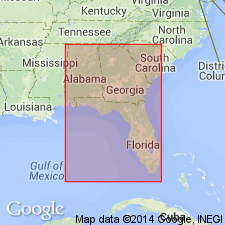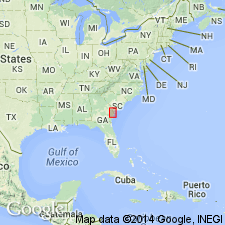
- Usage in publication:
-
- Suwannacoochee Dolomite
- Modifications:
-
- First used
- Dominant lithology:
-
- Dolomite
- AAPG geologic province:
-
- Florida platform
Summary:
Name Suwannacoochee Dolomite credited to Huddlestun (in press). Unit is described from core at Ellaville, Suwannee Co., FL, generally considered the type area of the Suwannee Limestone. Occupies interval between 18 ft and 23 ft 6 in. Consists of very porous dolomitic mudstone, with nondolomitic white limestone clasts scattered throughout. Contains good intraformational conglomerate from approximately 20 ft 6 in. to 22 ft, and fenestral fabric from 22 ft to 23 ft. At 23 ft consists of dark brown dolomite. Underlies undifferentiated post-Oligocene siliciclastics. Overlies Ellaville Limestone (first used). In Bass 1 core from Madison Co., FL, Suwannacoochee underlies Suwannee Limestone at a depth of 175 ft to 192 ft. Age is Oligocene.
Source: GNU records (USGS DDS-6; Reston GNULEX).

- Usage in publication:
-
- Suwannacoochee Dolostone
- Modifications:
-
- Named
- Dominant lithology:
-
- Dolostone
- AAPG geologic province:
-
- Florida platform
- South Georgia sedimentary province
Summary:
Name Suwannacoochee Dolostone is formally proposed is the area of the Suwannee and lower Withlacoochee Rivers in Madison, Hamilton, and Suwannee Cos., FL, and in the subsurface of Thomas and Brooks Cos., GA. Rocks have formerly been included in the Hawthorne Formation, the Tampa Limestone, and most recently in the Suwannee Limestone, which is revised in this report. The Suwannacoochee shares its type section at Ellaville with the Ellaville Limestone. Unit crops out discontinuously along the Suwannee River for approximately 10 mi. A reference section is designated in the core Thomas 4 (GGS-3188), approximately 2.4 mi northeast of the center of the village of Boston in Thomas Co., GA, interval 217.5 ft to 273.5 ft. Typically, the unit is a gray or buff to tan to brown, thin-bedded to massive and structureless, fine-grained, exceptionally hard and resistant dolostone. A thin marker bed of dark gray to black, dolomitic clay or buff, clayey dolostone consistently occurs at the base of the unit in GA. In FL, this clay bed is replaced by a thinly bedded dolostone with scattered layers of intraformational breccia. Recrystallization has been more extensive in the type area than in GA, where the dolostone is slightly argillaceous, thinly bedded to laminated. Unit also includes rare chert, carbonaceous material, and molds of very small mollusks. Thickness in the type area ranges from 11 ft (3.4 m) to 15 ft (4.5 m) at the type locality. In GA, the thickness ranges from 9.5 ft (2.9 m) to 56 ft (17 m) in the reference core. Everywhere conformably overlies the Ellaville Limestone and conformably underlies the Suwannee Limestone. Unit pinches or wedges out eastward in GA and FL in the vicinity of the Peninsular arch and grades laterally northwestward into the upper part of the Bridgeboro Limestone. Southern extent is unknown, but it probably underlies at least parts of Taylor Co., FL. Age is early Oligocene (Vicksburgian, Rupelian) based on stratigraphic position and the macrofossil RHYNCHOLAMPAS GOULDII.
Source: GNU records (USGS DDS-6; Reston GNULEX).
For more information, please contact Nancy Stamm, Geologic Names Committee Secretary.
Asterisk (*) indicates published by U.S. Geological Survey authors.
"No current usage" (†) implies that a name has been abandoned or has fallen into disuse. Former usage and, if known, replacement name given in parentheses ( ).
Slash (/) indicates name conflicts with nomenclatural guidelines (CSN, 1933; ACSN, 1961, 1970; NACSN, 1983, 2005, 2021). May be explained within brackets ([ ]).

